24 min read
Episode 246: HubSpot Personalisation, Smart Content Tips and Strategies
 HubShots
28 May 2021
HubShots
28 May 2021
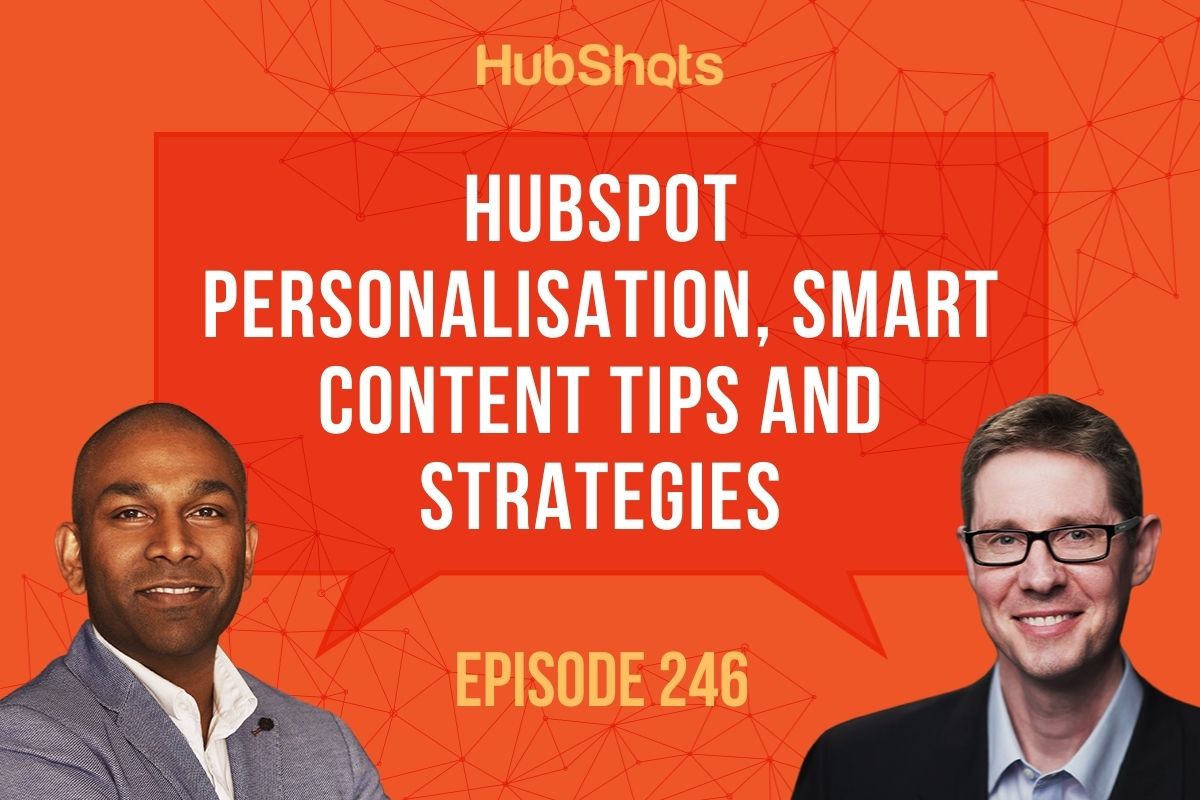
Welcome to HubShots Episode 246: HubSpot Personalisation, Smart Content Tips and Strategies
This edition we dive into:
- The ‘Amazon Experience’ and content personalisation
- HubSpot Smart Content enhancements and tips
- Embedding external content in HubSpot dashboards
- How people read online in 2021
- Google I/O 2021 was on
- Insight: Thinking past marketing (for CMOs)
- So many bonus links it hurts
You can listen to this episode of the show here.
Did a colleague forward this episode to you? Sign up here to get yours every Friday.
Please forward this on to your work colleagues.
Recorded: Monday 24 May 2021 | Published: Friday 28 May 2021
Shot 1: Growth Thought of the Week
The Benefits of Personalisation
You probably take your Amazon website experience for granted now, but there was a time not so long ago when the personalised state of their home page would have seemed like magic - how do they know you so well?
Even their emails were amazing, recommending you things that were exactly what you liked.
Perhaps you’ve even been aware that you wished other sites were like this - or at least other emails…
As marketers we refer to this as ‘personalisation’ ie the process of personalising your experience to be in line with your interests.
Whilst most companies can only dream of getting anywhere close to the ‘Amazon experience’, we can make some simple initial steps. Enter HubSpot’s smart content functionality. Smart content allows the content to be ‘switched out’ based on visitor criteria (eg where they came from, what device they are on, and whether you know specific details about them).
Although the core smart content has been available in HubSpot for many years (it’s been available with rich text modules), this month saw the rollout of smart rules to all types of modules including custom modules.
In the Shots below we’ll dive into an overview of the smart content feature, and some simple examples you may wish to try.
But first...
Shot 2: Quick Shots of the Week
Here’s a few quick items of interest we noticed:
- Instagram changed their policy, and in doing so broke all the HubSpot Instagram modules in the HubSpot Marketplace - we currently don’t have an easy way to add Instagram feeds to HubSpot pages
- Collaboration Sidebar in Ads, Forms, Marketing Email and Campaigns
- New properties for Marketing Campaigns, Campaign Owner, Start date, End date, Campaign Goal & Audience
- Associate your Ads with your Marketing Campaigns, another step forward into bringing it all together. Note that you will need to make sure that all the ads you're running are structured well from a campaign level.
Shot 3: HubSpot Marketing Feature of the Week
Smart Content FTW
HubSpot has enhanced the Smart Content functionality - you can now apply Smart rules to almost all module types - including custom modules.
In the following screenshots I’m going to walk through some of the screens when using in a Theme purchased from the HubSpot Marketplace - I thought this would be of interest since it will be different to the usual screenshots you’ll see in HubSpot Knowledge base articles.
Here’s an example of how it looks when using the CLEAN Theme (from our friend Kevin at Helpful Hero). It’s a simple matter of adding a Smart Rule:
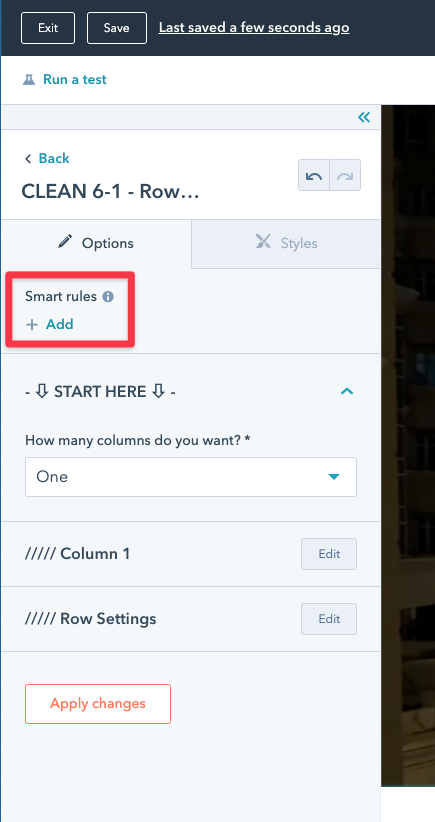
You’ll be able to choose from a selection of smart rule ‘categories’:
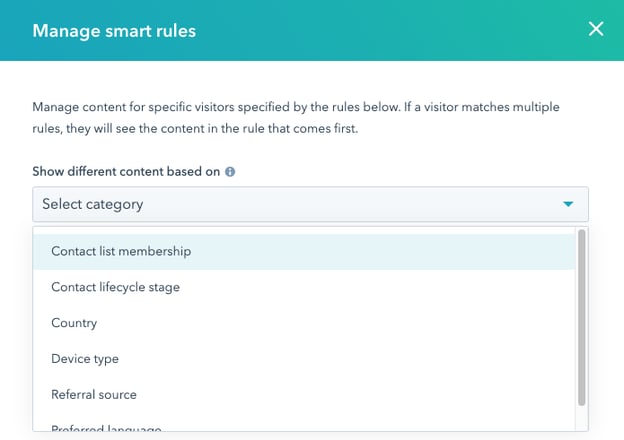
In this example, I’ve chosen Contact List, and then selected one Active list (but you can select multiple):
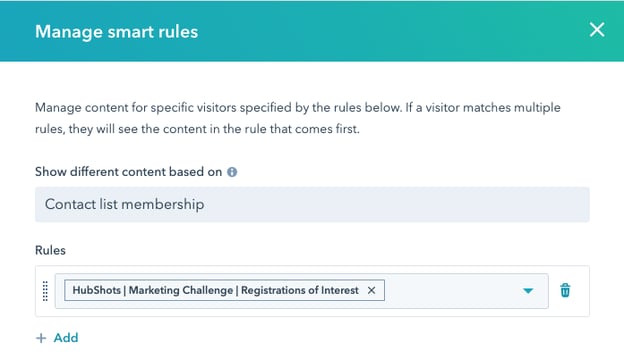
Using a Contact List is likely your most powerful option, since you can build Active Lists based on any of the hundreds of criteria on a contact record, including both attributes (eg job title or if they have a phone number or not) and behaviours (eg pageviews or email opens or form submits)
Here’s how it looks once the Smart rule has been added:
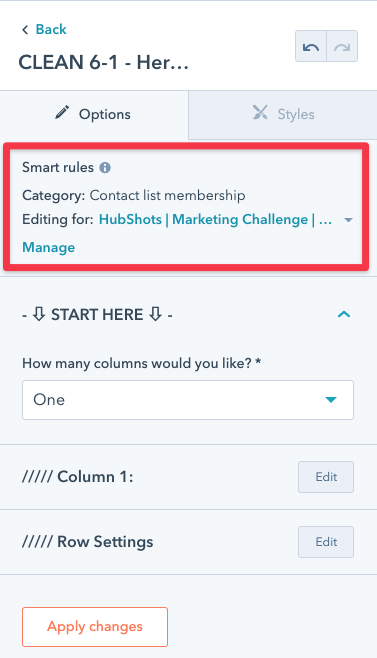
There are a bunch of other ‘categories’ you can select from:
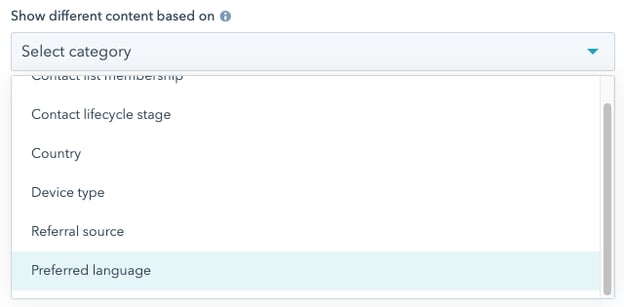
Referral Source is an interesting one, with the ability to set rules based on whether the visitor came via organic, referral, social, email, paid, direct and other:
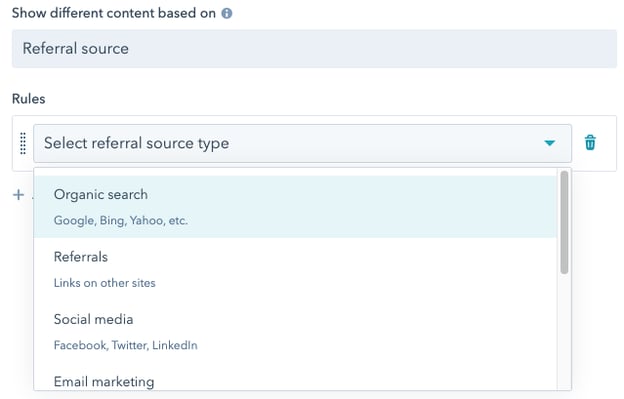
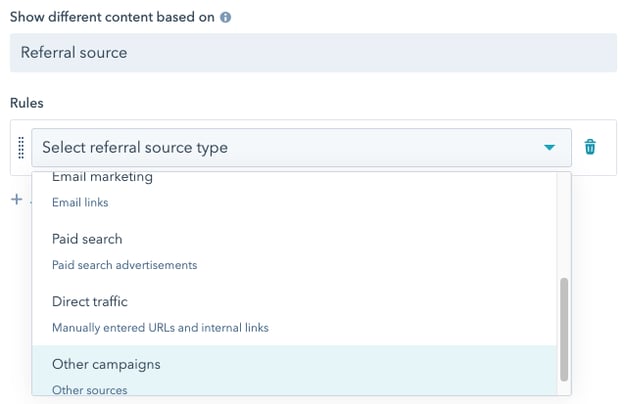
Most of these referral source types then allow you to select a set of campaigns to match against.
Interestingly, the rule for Social Media as a referral source still includes Google+ as an option (lol)
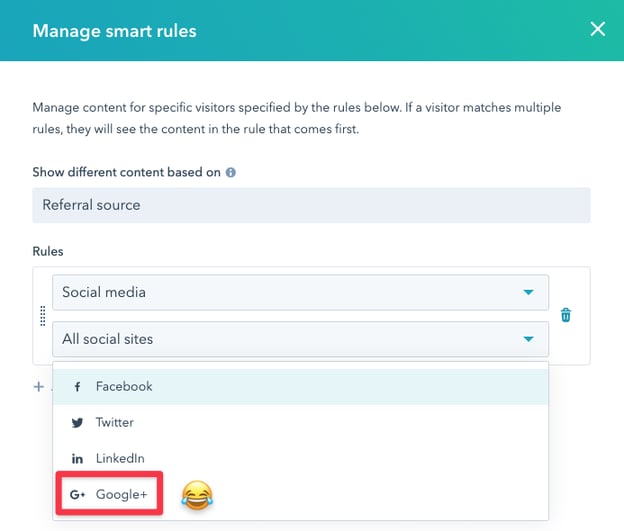
Some Examples of Using Smart Rules
Switching out pricing tables based on the Visitor’s country (ie to show in local currency):
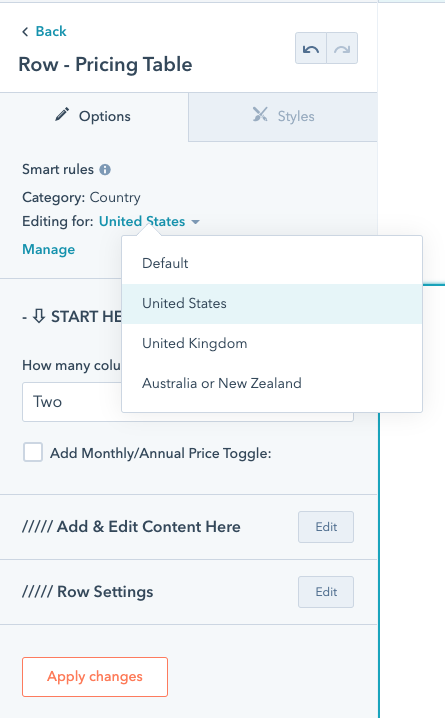
Mobile Versus Desktop
Smart Content - this test is for mobile vs non-mobile where we reduced the content to get the form more in place. Could also be that more people click to call from this page! (We have created a CTA with the number to measure this over the next couple of months!) You need to check all the data in this instance as you could assume that the smart content is performing poorly.
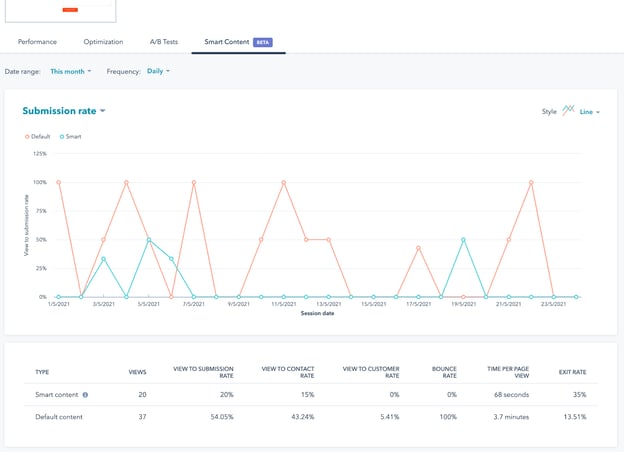
Here is the CTA we are using:
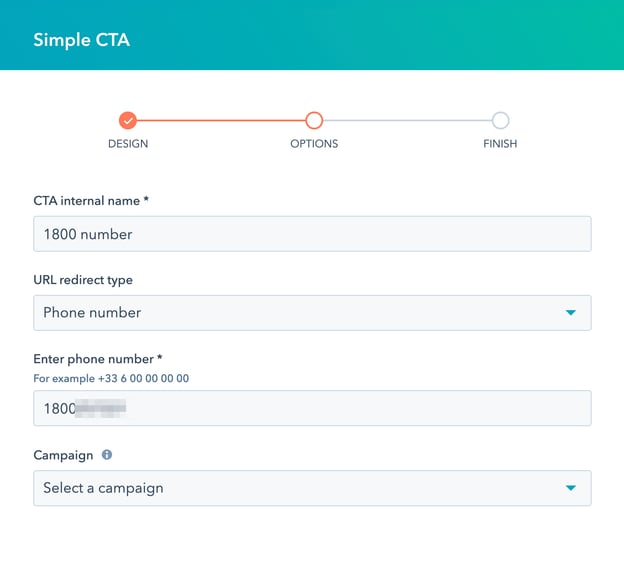
Shot 4: HubSpot Sales Feature of the Week
Using Meetings To Directly Connect With Sales Team/Owner
Having a smart rule to display the calendar booking if we have a Lead, MQL, SQL and Opportunity.
A good way to give people a direct way to talk to the person in sales they have been having a conversation with.

Shot 5: HubSpot Bonus Feature of the Week
Embed External Content on HubSpot Dashboard
A nice little feature was just added to dashboards - the ability to embed external content. You can find it on the Actions menu on each dashboard:
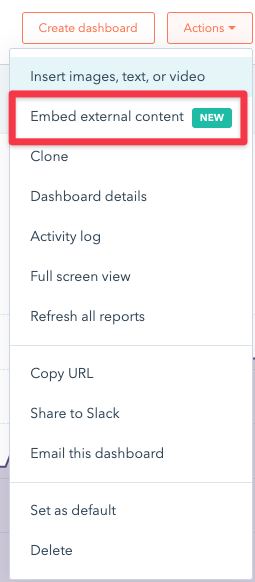
You can use an embed code (eg an iFrame), to include content from sources like Google Slides, Google Sheets, Databox, and more:
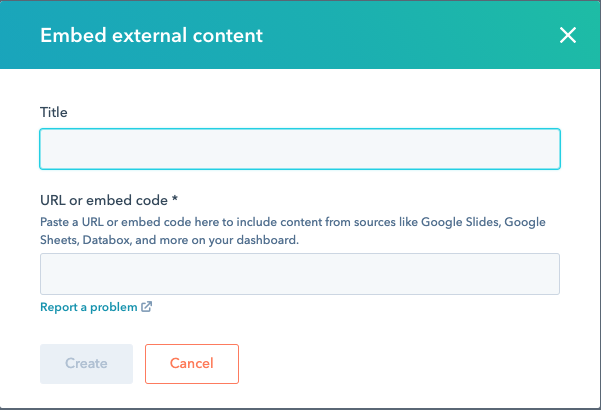
Here is an example Ian implemented for a client: 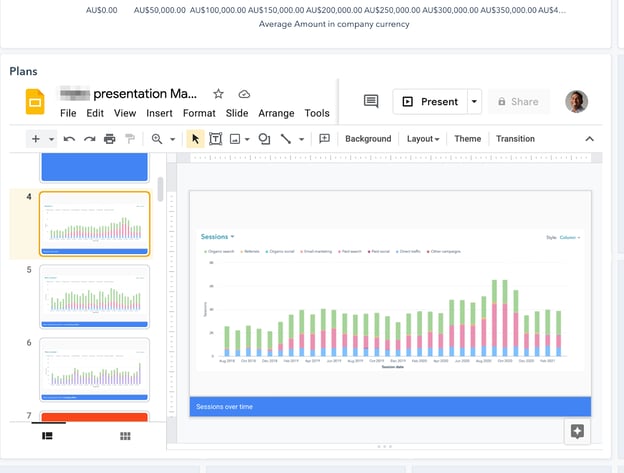
He’s embedded a Google Slides presentation, right into the HubSpot Dashboard.
Shot 6: HubSpot Gotcha of the Week
Default Image Optimisation Settings
Have you had this experience when building a landing page - you upload your company logo and it initially looks clear, but then when you view the live page the image has gone a little bit blurry?
If so, then chances are the image has been optimised automatically by HubSpot. This is a good thing for most images, but for company logos it can often be problematic. Thankfully though it is easy to fix - simply find the image in File Manager and tweak the Image Optimisation setting to High:
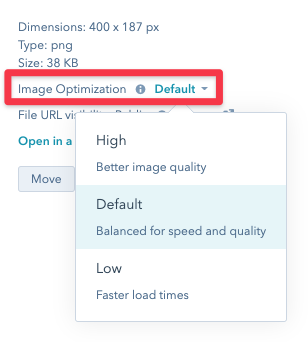
Shot 7: Marketing Tip of the Week
How People Read Online
The latest eye-tracking study by the Nielsen Norman Group (the second edition of their monster analysis) has found that the more things change, the more they stay the same. From the article discussing their study:
“We’ve been saying this since 1997: People rarely read online — they’re far more likely to scan than read word for word. That’s one fundamental truth of online information-seeking behavior that hasn’t changed in 23 years and which has substantial implications for how we create digital content.
The reason why that finding (and others discussed here) is still true is because it’s based on basic human behavior. Even though massive technology shifts have changed some behaviors, many of our original findings about how people read online remain true, even after 20+ years.”
However, there was one new pattern that has emerged - the so-called lawnmower pattern:
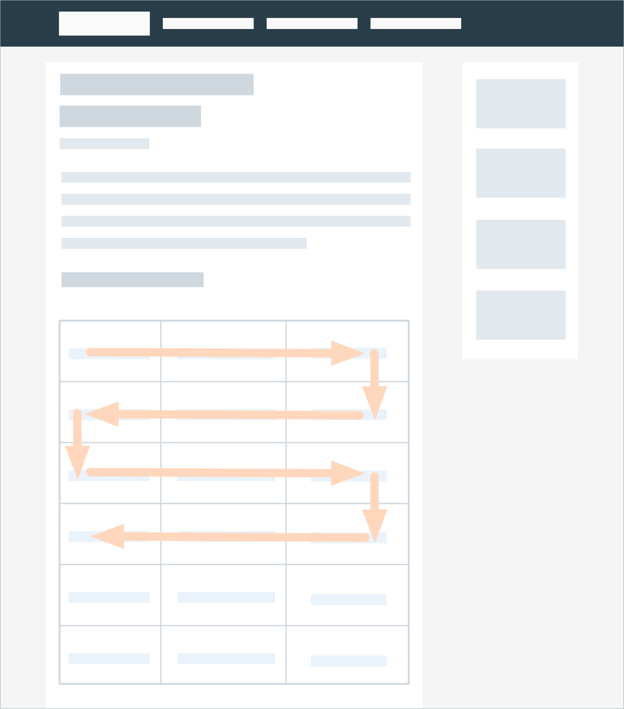
(Source: Nielsen Norman Group article)
By the NNG analysis, this corresponds with user behaviour against search result listings and ecommerce product listings.
Key takeaways: Be aware that people scan, and often in non-linear ways down the page
Shot 8: Insight of the Week
As Marketers We Need to be Thinking Wider than just Marketing
With HubSpot’s recent release of Operations Hub, you may be thinking (as a marketer) that it doesn’t really apply to you. Operations and integration is someone else’s area.
And that’s probably a reasonable position to take. But I’m going to suggest that’s the first step down a path that limits your career. The CMOs of tomorrow will be across much more than just marketing. They’ll be taking ownership of the contact database, ensuring it is cleansed and enriched, central to the entire enterprise. They’ll be focussed on ensuring the CRM is constantly increasing in value, with reliable data, and actionable reporting. They’ll be monetising the database.
This is much more than just running campaigns and looking after brand look and feel. This is about refining the gold, not just panning in the creek.
Dharmesh and HubSpot have big plans here - think deeply about what their 5 year intentions are. These are glimpses into the future and what they are thinking about.
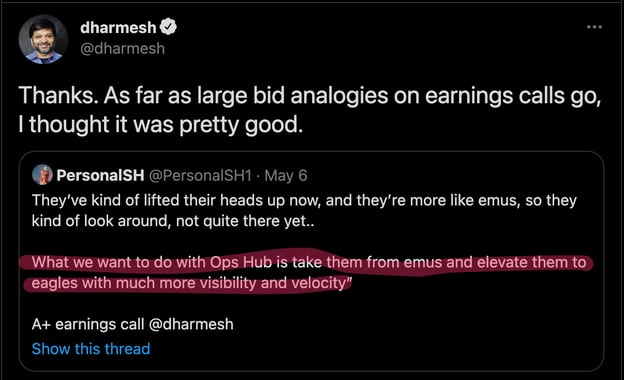
Shot 9: HubShots Throwback of the Week
Via the HubSpot product updates blog.
This time a year ago HubSpot added the ability to Add Multiple Domains to Companies in HubSpot.
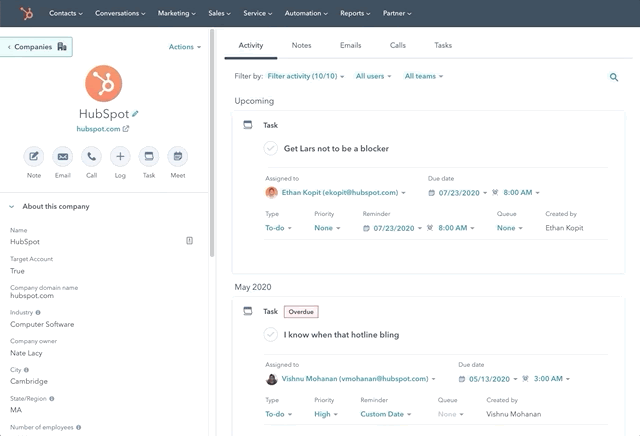
Shot 10: Resource of the Week
Google I/O 2021 Recap
If you are a Google watcher you likely know that they held their annual I/O event last week. There were a ton of sessions, covering new and improved items in the SEO world.
Thanks to Olga who put together this SEO Takeaways recap. And yes, Core Web Vitals does feature a lot.
Amongst the announcements, Google introduced MUM - a new AI milestone for understanding information.
Shot 11: Quote of the Week
“The smart way to keep people passive and obedient is to strictly limit the spectrum of acceptable opinion, but allow very lively debate within that spectrum.”
- Noam Chomsky in 1998 (Overton Window)
I’ve been thinking about this a lot lately...interesting!
Shot 12: Bonus Links of the Week
Google’s AI Can Predict Gender from a Retinal Scan
I was fascinated this week to learn that Google’s AI can predict gender based on retinal scans, but doctors still don’t know how it does it. Full report here.
Other Stuff
There’s so many useful links to cover, that I didn’t have time to flesh them all, so instead here they are in a nice bulleted list for you:
SEO
- Marie Hayes on whether you should continue to disavow spammy links in 2021. Answer: sometimes
- The always excellent ahrefs have an unsurprisingly excellent Beginner’s Guide to Technical SEO
- Sitebulb have a thorough overview of implementing redirects for SEO
- Be aware that when Google Quality Raters are checking your site, they view it as a mobile user (read the guidelines here).
- How Google Uses Machine Learning
- How Google fights web spam
Social
- Understanding the different Instagram profile types: Personal, Business, Creator
Paid
- Hootsuite’s guide to LinkedIn ads
Twitter threads:
Shot 13: Big Shots of the Week
LinkedIn Lols
I love this Twitter quote, where someone simply labelled the following as ‘How to do LinkedIn’:
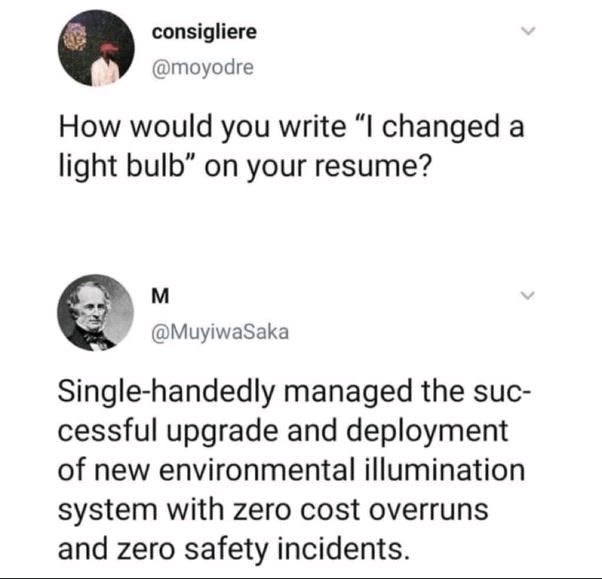
New Zoom Setting
On another matter - who thinks we need this in the zoom settings:
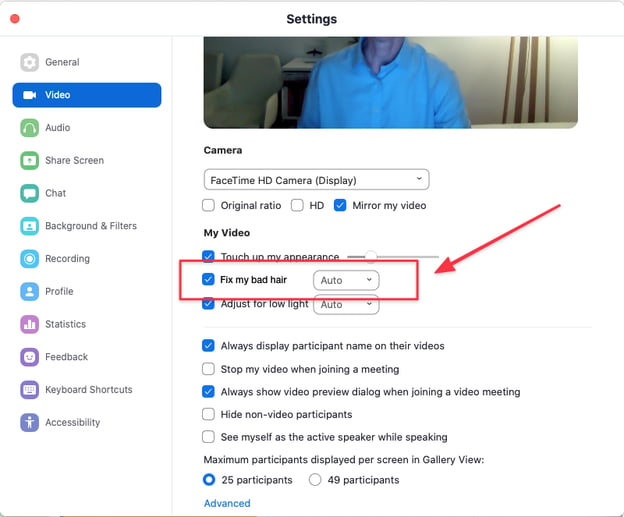
Shot 14: Follow Us on the Socials
Connect with HubShots here:
- HubShots YouTube channel
- HubShots Spotify channel
- HubShots iTunes
- HubShots Facebook group
- HubShots Twitter
- HubShots Twitter Show Notes
- HubShots Instagram
- HubShots LinkedIn
Connect with Ian Jacob on LinkedIn and Craig Bailey on LinkedIn
HubShots, the podcast for marketing managers and sales professionals who use HubSpot, hosted by Ian Jacob from Search & Be Found and Craig Bailey from XEN Systems.
HubShots is produced by Christopher Mottram from Podcastily.
Please share this with colleagues - it helps us improve and reach more marketers.
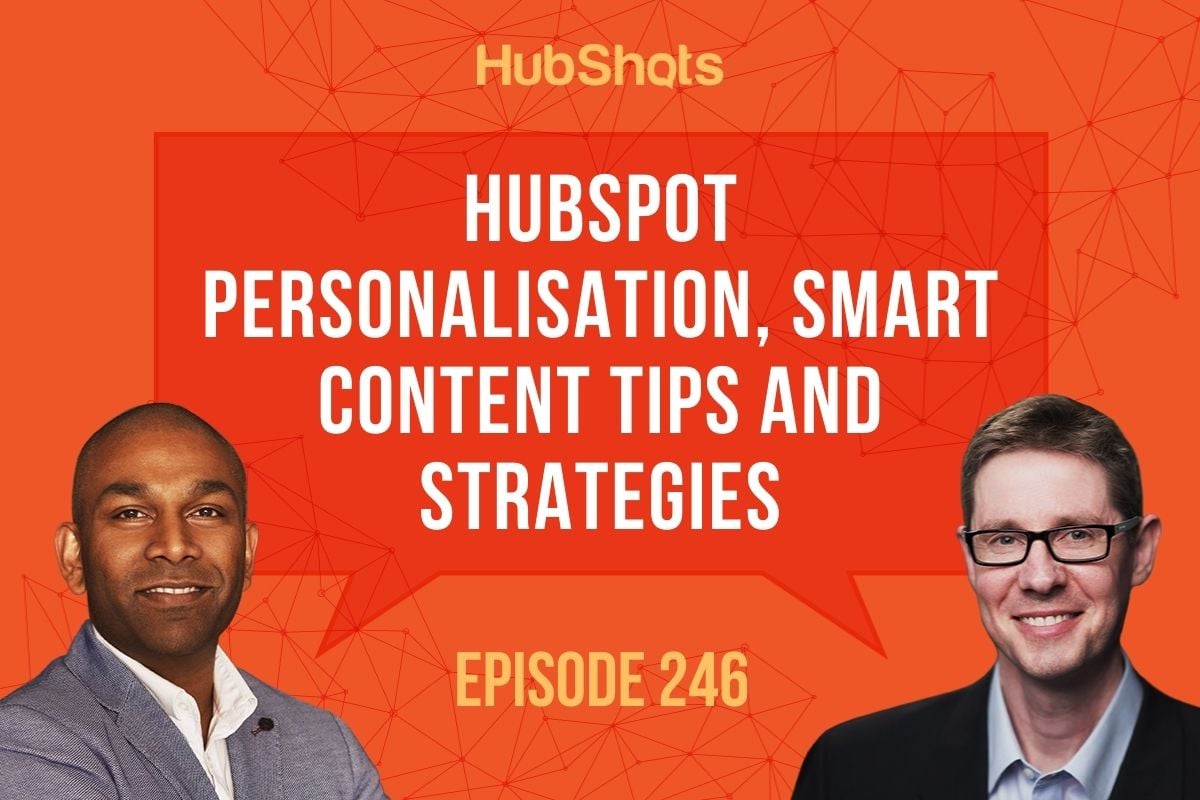
Full Transcript of HubShots Episode 246
- Hi, everyone. Welcome to HubShots Episode 246. In this episode, we talk about HubSpot personalization. The use of smart content tips and strategies. You're listening to Asia Pacific's, number one, HubSpot focused podcast, where we discuss HubSpot tips, tricks and strategies for growing yourselves, service, marketing, and now operations, results. My name is Ian Jacob from Search and Be Found. And with me is Craig Bailey, from XEN Systems. How are you Craig?
- I'm well, good to be back. And thanks listeners for your patience. We took last week off, didn't we Ian? And that was my fault.
- It's all good, it's all good Craig.
- Because of things, life gets in the way. But good to be back. And a great topic to talk about tonight, after we've gone through some of our quick shots, isn't it?
- That's right. So let's start with our quick shots, and then we'll dive into personalization. So the first thing is, Instagram has changed their policy, And in doing so, broke all HubSpot Instagram modules.
- Yes, so if you've got an Instagram feed in your HubSpot site, it's probably stopped working. And you've probably gone, "What's going on?" So this happened for us, for a bunch of clients.
- Yeah that's all Instagram's fault. It's not HubSpot's fault. And a bunch of modules in the HubSpot marketplace. In fact, we contacted a few of them, the provider there said, "Yep, sorry, it's broken. You've gotta do all kinds of crazy things to get it working. Like having a PHP server and all this kind of stuff." And they've, yeah they've actually just taken their modules out of the marketplace.
- Wow.
- Yeah, cause Instagram, I'm actually, I think it's so ridiculous. And I actually think Instagram will probably change again. So I'm waiting for that to be fixed. But yeah, a bunch of some of the areas appearing on home pages of our clients-
- Wow. Seems to get annoying, yeah, very frustrating. So, if that was you, then I share your pain.
- The next thing is, over there, is a collaboration sidebar in ads, forms in marketing email and campaigns. And not to mention, some of the shift of menu items within HubSpot, Craig.
- Oh yeah. Did you notice landing pages, straight out the market now?
- That's right.
- Yeah having that sub menu, I'm just waiting for when automation. You know, workflows. That'll just appear on the marketing.
- That's right.
- I guess that is across other hubs as well but-
- It is across other hubs.
- Most of all, it's yeah. I think that's gotta shift. The automation menu, I think, yeah, it's got a target on someone's back.
- But that's all right. I think it says incremental changes, right? But what I like about this collaboration sidebar, it gives you the ability to make comments. In ads, in forms, in marketing emails and in campaigns with other people within the team. And I think that's a big step.
- Yeah. Yeah I agree.
- Also something new that some people might be aware of. There are new properties in marketing campaigns. Which include campaign owner, start date, end date, campaign goal, and audience. And I think this is another good step, towards understanding more about your campaigns. And the last one that I love Craig, is the association of ads with your marketing campaigns. And this is another step forward in bringing this all together, within the campaigns tool. Now I was gonna, when I was testing this ad, I wanted to include a particular ad, or let's put an ad group for a campaign that a client was running. And because the ad pertaining to that campaign was in an ad group. And it was in a campaign that included other things, I couldn't do that. And were unhappy to run those ads. So, my tip to listeners is make sure you are organizing your ads correctly, in your campaigns. So you can associate them to the right marketing campaigns within HubSpot. All right listeners, onto our growth thought of the week, which is the benefits of personalization.
- Let's frame this by talking about Amazon. 'Cause everyone knows that Amazon experience, right? You go to the homepage on Amazon. "Oh, did they create this page just for me? It's exactly what I want." Or you get one of their emails.
- That's right.
- It's like, it's been tailor-written for me. So we all know that Amazon experience. And we all aspire to it. And most of us will never get close, you know. I'm sorry to burst your bubble, but the most of us will never get close, anywhere near that. But nor do we necessarily have to. However, we can make the first step down that path to personalization. That's what we're gonna talk about tonight. Specifically around HubSpot's smart content. Which they've enhanced. Been in the product for ages, but they've enhanced recently. We're gonna talk about that. And it's taking that first step, on personalizing the experience, for your visitors that could be contacts or that could be customers. And making sure they get something that is tailored to them.
- That's right. And in the shuts below, with a dive into some of those smart content features. And how you would use them in your business, Craig. Because that's the whole thing, right? It's great having these smart content reaches. But how do we utilize them effectively in our businesses? And that's what we're gonna dive into.
- That's right? Because otherwise it becomes a great feature for demos, but never in the real world. And I'm sure that, I'm sure that telemetry would bear that out. However, let's talk about how easy it is. And in particular what's changed. 'Cause people might, listening to this might be saying, "Well, what's changed. You know, we've had smart content freighters." Yep. You've had it in rich text modules.
- Correct.
- And perhaps even smart forms. So you can switch out forms, right? But now, the enhancement that HubSpot's made, is they've actually added this smart roles feature to every module. Even custom modules and things like that.
- I know. I love it.
- I love it as well. So you can tailor every part of a page now. And in the show notes, which by the way you should subscribe to hubshots.com/subscribe, is tons of screenshots. And what we've done is we've actually chosen, well we're working with a theme. We're working with the claim theme,
- That's right.
- Which is Kevin from Help For Heroes, shout out to Kevin. And we wanna show you screenshots of just using a theme, and how it appears there. Because most of the screenshots you'll see in, knowledge based articles and that from HubSpot, are just the generic modules. Here is how it looks when you actually use the theme. So we walk you through. And it's really nice cause we love the claim theme. You can just click "smart role" and then you add. So it doesn't matter what type of module, you can actually add smart roles. And so, some of the ones, the screenshots we've got, are just, say using a hero image at the top. And for example, if you go to, HubSpot's 28 day marketing challenge, you can see that we've actually tailored the hero message there. We've changed the CTA to change if you've already registered, things like that. So they're just simple things, for turn visitors. But what are some of the different categories, that we can actually put smart roles on?
- Right. The first one and most common one is the content list membership. The next is the contact lifecycle stage. We've also got country device type, referral source. And now preferred language.
- Yeah, so let's dive into this. I actually think using contact lists, is the most powerful. Because you can build an active list on any-
- That's right.
- Attribute on a contact. So that can be not only attributes, job title, et cetera. It can also be behaviors, number of pine trees, number of marketing emails they've opened, the time between visits, all these kinds of things. So you can actually build lists on that. And then use that, as an entry into a smart role, to switch out content. You're essentially switching out content based on any of these categories. Now one, I'll just draw your attention to, is referral source. And just a bit of a law, referral source can be social media. And then if you choose the social media choices, did you see Google+ is still in there?
- I say it's hidden there Craig.
- Hidden there, Google+. I knew that was still alive. HubSpot knows something we don't.
- Maybe it's coming back.
- Anyway, what it highlights though, is you can be very granular. You can say, a smart role based on a particular social media, visitor from particular social media site. Switch out the content based on that. So that's the level you can get to. We've got some examples. One I liked was pricing table. You might switch out a pricing table based on the country that they're visiting from.
- That's right.
- You know, pricing might be different, or different currency code, those kinds of things. You've actually got a good example of using device type, mobile versus desktop.
- That's right. I have. And what was interesting is, looking at this graph that we put in the show notes, is you would see, I've looked at submission rate, right on the smart content module. And we did that based on if there were a mobile device. I've actually taken a lot of the content, to get them to their form quicker, or to make the core. Now what's interesting is, if you look at the stats, you'll go, "Jay, that's smart content's really underperforming." But one thing to understand is, it was a page for a company that people wanted to have a rental. So reduce the amount of content. Just put the really pertinent content on the mobile device, and the form. And one of the things that I did wanna check is that where they're actually clicking the numbers. So, as a result of looking at this, I created a call to action, with the phone number. So I can track to see where the people are clicking the number. And whether it's mainly on a mobile device. All right. Onto the HubSpot sales, which is the week Craig? And here is where we can use our meetings to directly connect with the sales team owner. And in here, we're having a smart role, to display the calendar booking. If we had a lead, an MQL, SQL or an opportunity, as a way to give people a direct way to connect to the person they're talking to in sense.
- So, I really liked this, basically you've said, use lifecycle stage?
- Yes.
- To then switch out and show a meeting link.
- Exactly.
- And hide it.
- That's right.
- Otherwise if they're not on some other stages, correct?
- Yep. All right. Onto our bonus feature of the week. Craig, embedding external content on HubSpot.
- I love this. You highlighted this to me. Basically, listeners I think we talked about this.
- We did.
- We just talked about this a couple episodes ago.
- We thought it'd be really good to have it.
- We said, we were talking about dashboards. And you had said, "Oh, you know, you can put an annotation. And it remains there."
- That's right. Yes.
- And I was like, "Oh great." Do you know what I'd love to be able to do is? Embed an iFrame or something like that. Well, basically it's in there now.
- They listened to you Craig.
- Well, I'm not gonna say they listened to me, and put it in. I'm sure it's been planned. It was probably been on, that's probably been on their backlog for months, right? Months and months and months. And I just happened to mention it, and then a couple of weeks later. So, I'd love to people to think, you know, give me credit for that. But I'm sure it's been in Roadmap freighters. But, that's beside the point. The point is, it's hidden here. And what you can basically do, is embed anything. So you've actually got an example here, where you've embedded Google slides deck in there. You could embed a databox report. You could embed anything with an iFrame. All kinds of things. And so here we see, I don't think people quite realize how powerful this is. You've gone from saying, "Oh HubSpot's got its own dashboard, right? Oh, and we've gotta use it in conjunction with other tools to like-" Oh no, we just use the HubSpot dashboard. And we pull the other tools into the HubSpot dashboard.
- Correct.
- This is powerful. Why would you leave HubSpot Ian? You just sit in HubSpot all day. You know what-
- You know when I embedded this slide. I was able to actually edit the slides from within HubSpot. And so I was just like, wow hang on a second. And so, listeners you'll see a screenshot in there. And yeah I was blown away. I thought okay, maybe it's just a view, or anything. But I just had that whole 18 experience within that frame.
- Oh yeah. It's great. You know what they need, they need a Twitter Radar. So I can just go into HubSpot, and read my Twitter feed. Oh, hang on. They've got that under the social films. What do I need to do? They just need, you know what? I can just connect my inbox, into conversations. I never know it, they have sorted. I just try in and then hold on.
- Oh, there you go.
- Ian Jacob with that one.
- All right. Onto HubSpot's got you the week, Craig. And this is to do with default image optimization settings.
- Hi, have you ever had this experience? You building a landing page, you might have the logo, you know the client's logo, you're putting it on there. It looks great. Then when you look at the actual page live, it's like, ah the logo is a bit boring. What's going on? The logo is resized wrong. What's going on? No, what's happened is HubSpot's default image optimization has taken effect. And it's just reduced it down in size. And reduced a bit of the quality. So you're like, "Oh man." Now that works for a lot of images. Especially in other stock images, and pictures of people and all that kind of stuff. But for logos are very specific. Sometimes very specific infographic pieces. You don't want that to happen. Easy fix, go and find the image. Go into file manager, find the image. And I've got a screenshot in the show notes. You just flick it from the default, to high. Still keeps the better quality image. So especially for logos.
- All right, onto our marketing tip of the week, Craig. How people read online.
- The Nielsen Norman Group have released, a second edition of their monster kind of analysis. Eye-tracking study on how people read web pages.
- Yep.
- And linked to like, that's a paid report. But they've got an article about it. Which goes into some of the highlights. We've pulled a few of those out, in the show notes. We won't go through them all. But, just to mention in many ways, nothing has changed. For example, people scan. They don't really read web pages. They scan. But one new thing is, the pattern that they scan, has kind of changed. And this, no longer refer to this, as the "lawn mower pattern". And it's kind of a go down, go right, go down, go left, go down, right. And sort of zigzag down the page. And it's a new kind of reading behavior. And in particular, they noticed this with search results pages. Because on Google if you think you kinda go down, then you'd jump over to the sidebar. Then you kinda go down a bit in the sidebar. You know, let's say it's a business listing. So you've searched business time. Oh, I jumped to the right-hand side bar, and see the business listing. I'm talking about desktop here, not mobile. And then you jump back into the middle search results. And then you go down, then jump over a bit. And you know how in Google business listing, they have, and people also search for at the bottom. Which I really find annoying. 'Cause they're searching for my brand. I don't want Google promoting competitive brands. Well, that's part of that lawn mower thing. 'Cause you go down, then across, then down, over and cross. So interesting things there. There's two takeaways, that I think listeners can take from this. One is that, behavior hasn't changed in terms of scanning. So if you're writing long wordy pieces, that's not gonna work. You really need to punctuate it with easy to read headings, and make it very scannable. But two, just be aware, that it doesn't have to be linear down the page, it can move across. And I give a good example of E-commerce Product Pages. And instead of all being listed one down below, is kind of a zigzag, you know, alternating. So you find companies doing that now. And it's basically because it correlates with how people view web pages.
- So Craig, I think what would be interesting is, how do people read a mobile web pages as opposed to desktop?
- Yeah, well mobile is very much more linear. 'Cause it's such, so much smaller. But also much harder to do eye tracking studies on those. And also people read those in different scenarios. So some people are looking down, 'cause they're just waiting in a queue. Others are on their commute home, on the bus kind of stuff. So yeah, I don't think we have enough data points on that. But I think it's telling though, that Google is, yeah there's only one column and we've seen. And that's why we've always said, for probably the last two years in, we've said the shift to your emails, should be single column.
- Exactly.
- Get away from mobile.
- So listeners, take away from this is, have a look at your pages. Especially if a bulk of your traffic, is desktop related. And see how people are using the page. And a really simple way to do that, is using something like Hotjar, and watch what people do. Because especially on desktop, you'll notice people move their mouse, where their eyes heading. And that is such a key giveaway, when looking and thinking about, how can I make that page better? Or give people something faster, than what they're looking for. So there's all insights. Talking about insight, onto our insight of the week, Craig. As marketers, we need to be thinking wider, than just marketing.
- Thanks to you for prompting me on this. Because you mentioned a tweet, that Dharmesh gave on on Twitter. Do you wanna give a bit of background, get a context of that tweet?
- Yeah, it was a tweet. I came across from an earnings call, and one of the person on Twitter called said, and they were talking about operations hub. So I think there's a questions about operations hub. And Dharmesh has responded like, they're kind of lifted their heads up now. And they're more like emus. So they kind of look around not quite there yet. But what we wanna do with ops hub, operations hub, is take them from emus and elevate them to eagles, with much more visibility and velocity. And that got me thinking, what are we missing when we think about operations hub? Or less when we thinking about a product? Or in this case operations hub in HubSpot. What are you missing and not saying, that the likes of Dharmesh and Brian, and the whole team at HubSpot are thinking about it?
- Yeah, it's a good question. And just to fill in the context that, so yeah, that email is an eagles thing. And referring to the fact that previously people had their head in the sand. I think that was the context.
- Correct.
- And it's kind of like, people don't know what's going on. I've got this data. I've got CRM data. I don't know what's going on. It's just silo, that kind of thing. And I think you're right and it's highlighting. And so the insight of the week, which I've written in the show notes, is around the idea that, marketers need to think more broadly than just marketing. And as marketing. And this is more for the CMO. But for just the marketing, executive marketing managers, they might think, "Oh, I'm just looking after marketing. And I've got brand style guidelines. And I've got my campaigns I'm running, and I've gotta get some assets." That's all, you know, that's it. And I'm not gonna look more broadly. And I think, that's potentially dangerous. And really as marketers, we need to be thinking across the company, in terms of the data. So, the CRM data, who owns that? Is that IT? No, I don't think so. Is that sales? I don't think so. Well, who actually looks after, I wanna suggest if you're the marketing person, you look after it. Because you have it now. But a couple of years down the track, you might not. So looking after it now, with a couple of intents in mind. So the first is, you've gotta keep it clean, and therefore reliable. And the second is, you should be looking to enrich it. So that it becomes more valuable. You've got to look at your CRM data as an asset. This is a valuable asset. Not something that just churns 30% a year. You know, on paper leaf, you've got to keep this clean. Because that's an asset for the company. And if you're the CMO, and in charge of that, that actually gives you a lot of value to the business. And so then coming back to what you raised in, it's this idea and what Dharmesh is alluding to. And you're asking the question, so what are they seeing with operations hub, five years down the track? And I don't know. But I think it's a good question to ask and to consider. Maybe we should ask Dharmesh that directly. But as marketers, we need to ask that. It's not just someone else's problem, it's actually our opportunity. And so keep that in mind listeners. If you're in marketing, what do you think HubSpot has in mind, for operations hub, five years down the line? What is their vision there? And it's very much, I would suggest around integration and ensuring, first of all HubSpot is the center of the universe, for everything in your business. You can see that's where they're going. But two, it's around protecting the data, and making it valuable and enriched. And as a CMO, that's your opportunity.
- I couldn't agree more Craig. I think it's one of those things, where I would challenge people to think about how they utilize the data. And how different people utilize the data. Like when we work across different teams, you might have say some, we might have the data in the system, right? But it's not readily visible to them. It's like, oh, I can't see that. And it could be clearly like, we need to create a separate view or we need to create a separate section on the contact dashboard, or the deal dashboard, or the company dashboard. That actually shows them that data, that's pertaining to them. So how do you do that? And how do you get everyone in on the same page, and helping you enrich that data for utilization? That's a really big point. All right. Onto HubShots' throwback of the week, Craig. And can you believe it this time a year ago, HubSpot added the ability to add multiple domains to companies in HubSpot.
- What?
- That's right.
- I didn't know about this.
- That was a year ago, Craig.
- No way. How did I not know about this? You know what? I really need to subscribe to that option.
- All right, now we've got, listeners we've got lots of resources. And this is from the Google I/O, 2021 recap. Craig, take it away.
- All right, so most of you will know that. Well, if you are Google watcher, you know they have their annual I/O Event. There's so many sessions on a variety of topics. But including SEO and search. And if you want the recap, thanks to Olga, who's put together a massive SEO takeaways recap, and I will just warn you. Yesco Web vitals features a lot. You cannot escape it. Amisco Core Web Vitals in. But we just can't escape it.
- It's here to stay Craig.
- It's here to stay. It's here to stay, but possibly, you know, I do wonder if the airtime is getting, it's way out of proportion. To the actual relevance that has. But anyway, that's just me. Still very important. Amongst the announcement, Google introduced MUM. MUM, a new AI milestone for understanding information. We've got a link to that. I'm not across that yet Ian. I've some interesting reading, I've got coming up in the next week.
- And listeners, we've got some bonus links. Which talks about Google AI. Can predict gender from a retinal scan.
- This is fascinating. Can I just explain this? I'll just quickly.
- I think you should.
- This is all about Google's AI and that. So what they did, this is nothing to do with marketing or such, although you'll see how it applies in a second. So they fit it all, this retinal scan. You know retinal scans people's eyes. And they, you know, looking for diseases and issues. But then, because they'd given part of the data set input, they'd put gender. Then they started saying, "Oh, to new ones. What gender is this? And could it pick?" And Google's AI worked it out, I forget the accuracy right? 85, 99, it was pretty high, but here's the thing. They don't know how it worked it out. That's just AI worked it out. So they actually don't know. And so now can you see where this is going? Imagine applying this to marketing. And AI works out, what advertising works better, or what campaign works better. And we don't even know why. But the AI works it out. Anyway interesting article there. And also it's like, you know, a proper peer reviewed scientific articles. So fascinating.
- And we've got quite a few resources, to do with machine learning. How Google fights web spam. And, we also have some Twitter threads on landing a page and copywriting tips. Which I encourage people to look at, because there's lots of great resource in there.
- So many bonus links this week.
- And finally, listeners, quote of the week.
- Do you want me to read this one?
- Go for it Craig.
- Okay this is from Noam Chomsky, way back in 1998 by the way. 20 odd years ago, he'd said, "The smart way to keep people passive and obedient, is to strictly limit the spectrum of acceptable opinion. But allow very low lively debate within that spectrum." I've been thinking about this a lot Ian, lately.
- Yeah and-
- I don't wanna say too much, but the thing it's, I guess, triggering in me,
- Yes.
- It is for one thing on social, you know, how people get on social, and just argue very lively. And often mainly about things. And part of me feels like, the debate is very heated in areas that aren't that important. And I wish the debate would be wider. But the second is, it's such a hard line between censorship of harmful things out, and yet challenging things in, that potentially we don't like. And you and I have chatted, not on the show, but we've chatted about some politicians that we do and don't like. And I think sadly some of the politicians that I have probably respected the most, have had hard line positions that I've completely disagreed with. Because they stood up for them. And, I've actually then voted to get them out. 'Cause I don't want their policy to go ahead. But yet at the same time I respect, they took a stand. And they were allowed to take that stand. That's just so happens. I totally disagreed with it. And I kind of like that. And yet we seem on social and other channels to be really limiting what we can talk about. And it's a hard line. I get that we've got to protect people and we don't want hate speech of course. But there's things that need to be discussed. And you know, more than 20 years ago, and well, forever it seems, we've been challenged not to, we just talk within the spectrum. So, I'll leave it at that. I won't say more.
- And listers, Craig has highlighted use zoom setting, which I would encourage you to have a look at. And you should subscribe to the show notes, so you can get the, get the screenshot of it.
- That's a knock out. Hey, what did you think of that LinkedIn loss?
- That was pretty funny.
- Oh men, do you wanna read that out?
- Yeah, let's read that out.
- Okay. So someone on Twitter said, "How would you write, I changed a light bulb on your resume?" Right? So I changed the light bulb. How do you put it in resume? This person's replied and said, "Single handedly managed the successful upgrade and deployment of new environmental illumination system, with zero cost overruns and zero safety incidents." I think that's great. And then someone on Twitter just put, "How to do LinkedIn.
- Well, this is, I hope you've enjoyed the show. And you can jump on some personalization. And, don't forget to register for our upcoming 28 day marketing challenge. And reserve your interest. And we will get back to you. Craig have a great week.
- Catch you later Ian.
- Hey there. Thanks for listening to this episode of HubShots. To get the latest show notes, HubSpot tips, and marketing resources, sign up at hubspots.com You can also book time with us to help you grow better, with HubSpot.
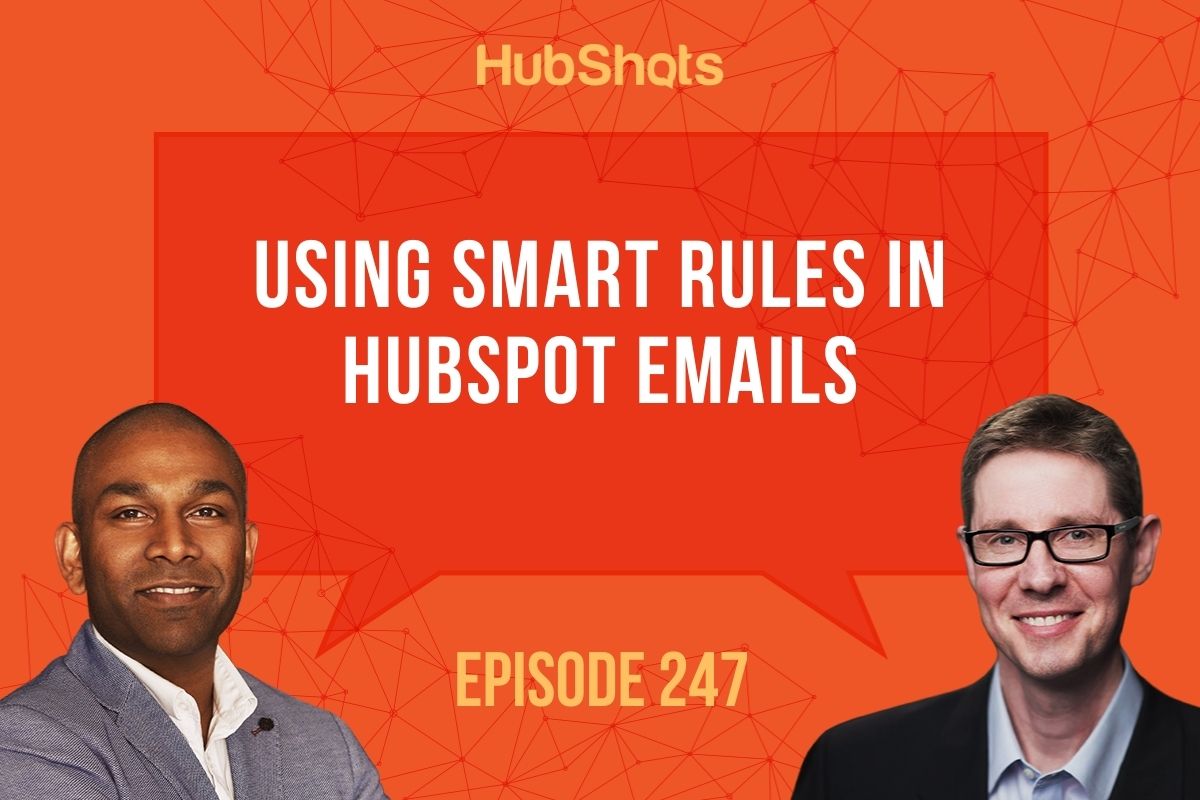
Episode 247: Using Smart Rules in HubSpot Emails
Welcome to HubShots Episode 247: Using Smart Rules in HubSpot Emails This edition we dive into: Creating simple Training Using Smart Rules in...
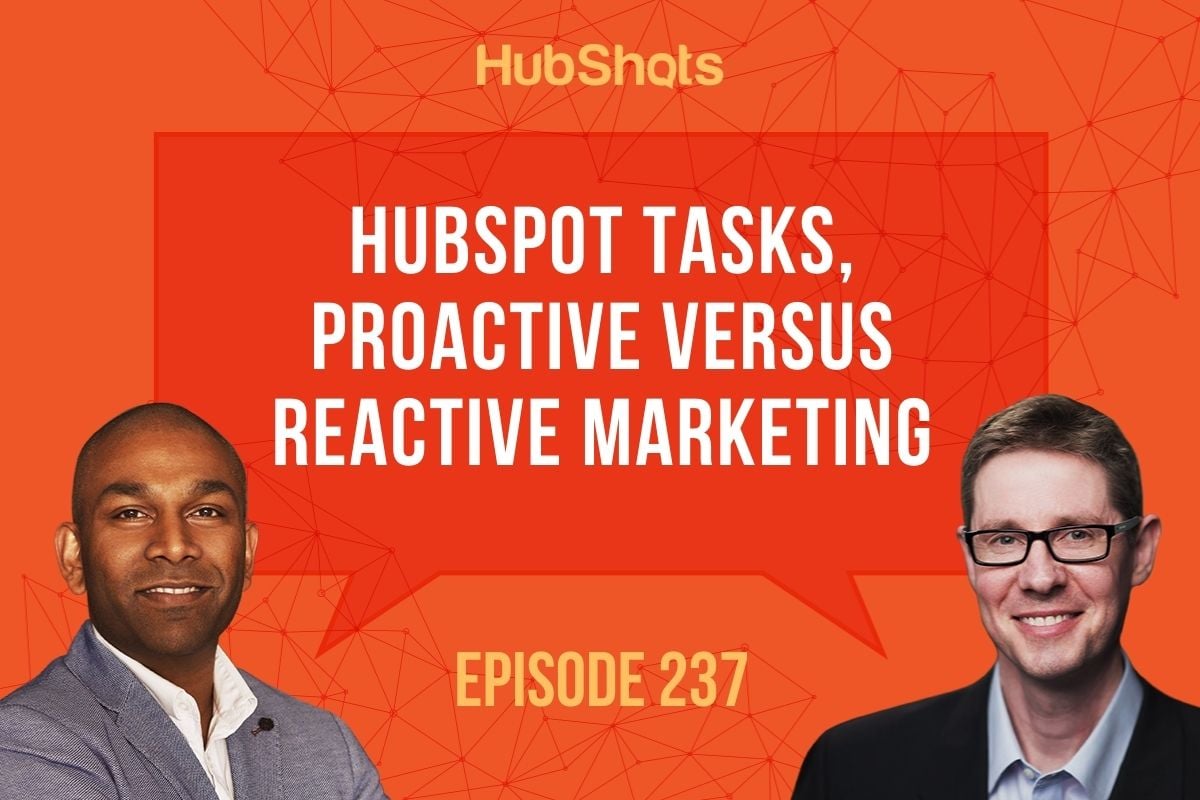
Episode 237: HubSpot Tasks, Proactive versus Reactive Marketing
Welcome to HubShots Episode 237: HubSpot Tasks, Proactive versus Reactive Marketing This edition we dive into: Facebook versus Australia follow up
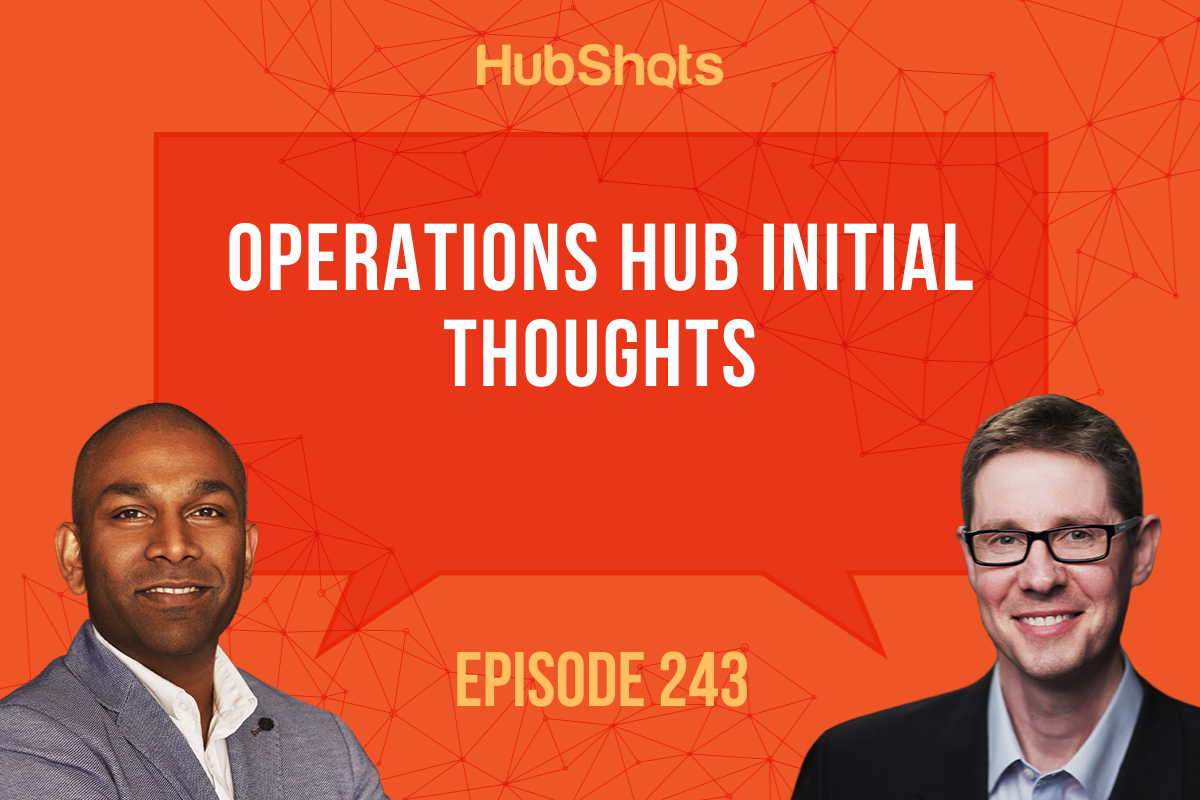
Episode 243: Operations Hub Initial Thoughts
Welcome to HubShots Episode 243: Operations Hub Initial Thoughts This edition we dive into: HubSpot’s new Operations Hub announcement HubSpot User...